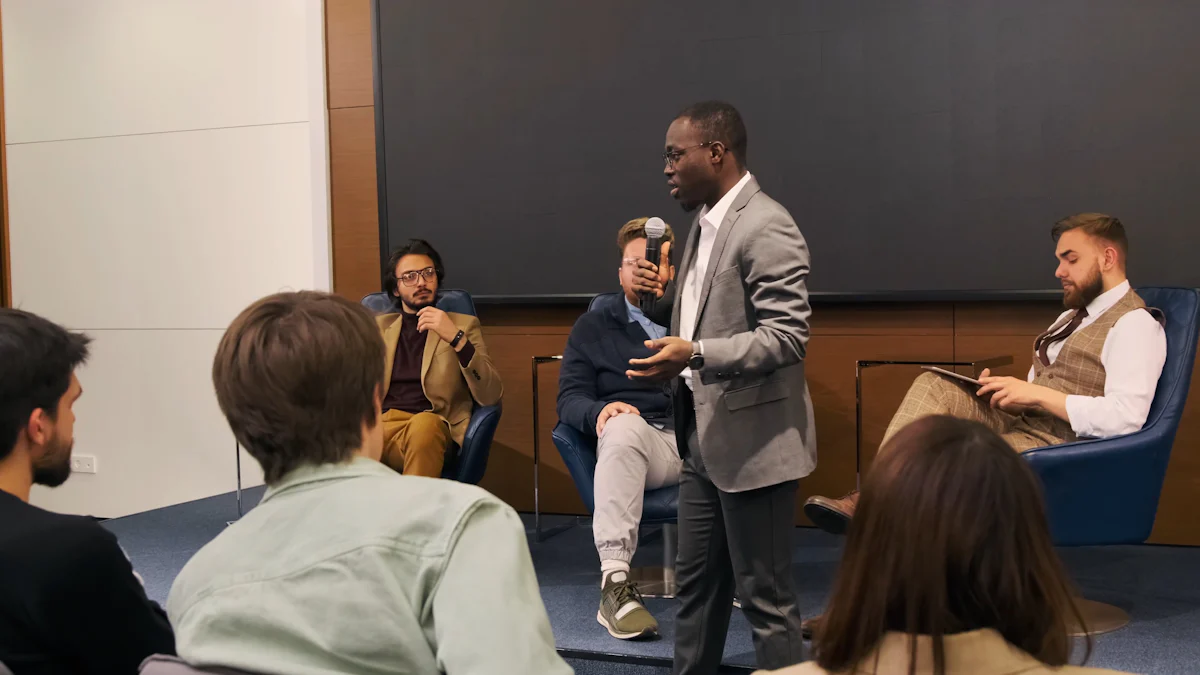Steps to Keep Your Audience Engaged During Long Presentations

Long presentations can feel like a marathon, but with the right techniques, you can keep your audience hooked from start to finish. One key question to consider is, how can you engage your audience when giving a presentation? Start by interacting with your audience early on. Ask questions or include a quick activity to grab their attention. Inject something exciting every few minutes—like a surprising fact or a thought-provoking idea—to keep the energy alive. Don’t forget to stay hydrated and take deep breaths during pauses. These small habits can boost your focus and help you deliver with confidence. Strong presentation skills aren’t just about speaking; they’re about connecting.
Start Strong to Engage Your Audience

Open with a Hook
The first few moments of your presentation set the tone for everything that follows. If you want to grab attention right away, start with a hook that surprises or intrigues your audience.
- Contradict Expectations: Say something unexpected. For example, if your topic is about productivity, you could open with, “Working harder doesn’t always lead to better results.”
- Make a Surprising Claim: Share a statistic that makes people pause. Imagine starting with, “Did you know that 70% of people forget most of a presentation within 24 hours?”
- Stimulate Curiosity: Ask a question that sparks interest. Try something like, “What’s the one thing you can do today to double your efficiency?”
- Tell a Story: Stories are powerful. Share a personal experience or a relatable anecdote that ties into your topic.
- State the Problem Clearly: Highlight the issue your presentation will address. For instance, “Many teams struggle with communication, but today, we’ll explore how to fix that.”
A strong hook doesn’t just grab attention—it sets the stage for meaningful audience engagement.
Clearly State the Purpose
Once you’ve hooked your audience, let them know why they should stick around. People want to understand what’s in it for them.
- Explain What the Audience Will Gain: Be upfront about the value of your presentation. For example, you could say, “By the end of this session, you’ll have three actionable strategies to improve your presentation skills.” This gives your audience a clear reason to stay engaged.
- Set Clear Expectations: Outline what the session will cover and how it will flow. This helps your audience feel more comfortable and focused. For instance, you might say, “We’ll start with a quick overview, dive into practical tips, and wrap up with a Q&A.”
Setting expectations isn’t just about structure—it’s about creating a positive experience. When you’re clear about what’s coming, your audience feels more at ease and ready to participate.
| Benefit | Description |
|---|---|
| Customer satisfaction | Ensures that the audience's needs are met, leading to a positive experience. |
| Efficient business operations | Reduces misunderstandings, streamlining processes. |
| Employee engagement | Increases motivation and participation during presentations. |
By starting strong and clearly stating your purpose, you create a foundation for a presentation that keeps your audience engaged from beginning to end.
How Can You Engage Your Audience When Giving a Presentation?
Ask Questions
Questions are a simple yet powerful way to keep your audience engaged. They encourage participation and make your presentation feel more like a conversation than a lecture.
Use Open-Ended Questions to Spark Discussion
Open-ended questions work wonders for sparking thought and conversation. They invite your audience to share their perspectives and ideas, creating a deeper connection. For example, instead of asking, "Do you agree with this point?" try asking, "How do you think this approach could work in your daily routine?" This type of question encourages a variety of responses and keeps the discussion lively.
Here’s why open-ended questions are so effective:
- They stimulate critical thinking.
- They invite diverse answers, making the session more dynamic.
- They help you understand your audience’s viewpoints better.
Encourage Participation with Polls or Surveys
Interactive tools like live polls or surveys can make your presentation more engaging. They’re quick, easy, and fun for your audience. For instance, you could ask, "What’s your biggest challenge with time management?" and display the results in real-time. This not only grabs attention but also helps you tailor your content to their needs.
Other tools you can try include:
- Quiz-enhanced slides to energize the room.
- Social media platforms to share live content.
- Physical props to make abstract ideas more tangible.
Create Opportunities for Interaction
Interaction is key to keeping your audience involved. It transforms passive listeners into active participants.
Include Group Discussions or Problem-Solving Tasks
Break your audience into small groups and give them a task to solve. For example, if your topic is about teamwork, ask each group to brainstorm ways to improve collaboration. This approach not only reinforces your message but also builds a sense of community among attendees.
Use 'Stop and Think' Moments to Encourage Reflection
Sometimes, a pause can be just as powerful as a question. Ask your audience to stop and think about a specific point. For instance, say, "Take a moment to reflect on how this strategy could apply to your current project." These moments give your audience time to process information and connect it to their own experiences.
By asking questions and creating interactive moments, you’ll master the art of engagement. These strategies not only improve your presentation skills but also ensure your audience stays focused and involved throughout.
Keep Your Audience Focused with Structure
Break the Presentation into Sections
Breaking your presentation into clear sections helps your audience stay on track. It’s like giving them a roadmap to follow.
Use Clear Transitions to Guide the Audience
Transitions are your secret weapon for keeping things smooth. When you move from one section to the next, use phrases like, "Now that we’ve covered this, let’s dive into..." or "Next, let’s explore..." These cues signal a shift and help your audience stay focused. Think of transitions as bridges—they connect your ideas and make your presentation flow naturally.
Summarize Key Points Before Moving to the Next Section
Before jumping into a new topic, take a moment to recap what you’ve just covered. This reinforces understanding and ties everything together. For example, you could say, "To sum up, we’ve discussed three ways to improve teamwork: better communication, clear goals, and mutual respect." Summarizing does more than just review—it helps unify your presentation and makes it easier for your audience to follow along.
Here’s why summarizing works so well:
- It enhances audience understanding.
- It connects different parts of your presentation.
- It keeps your audience engaged by reinforcing key ideas.
Include Strategic Breaks
Long presentations can be draining. That’s why scheduling breaks is essential for keeping your audience energized and attentive.
Schedule Short Breaks to Recharge the Audience
A quick five-minute break can work wonders. It gives your audience time to stretch, grab water, or simply reset their focus. You can even use this time to encourage informal networking or light conversation. Short breaks aren’t just a pause—they’re a chance to recharge and come back ready to engage.
Use Breaks to Reset the Energy in the Room
Breaks can also help you reset the room’s energy. After a break, start with something lively—a quick story, a fun fact, or even a question. This re-energizes the group and sets a positive tone for the next section. Think of breaks as a way to hit the refresh button, keeping your audience focused and ready for what’s next.
By structuring your presentation thoughtfully and including breaks, you’ll master the art of keeping your audience focused. These strategies not only improve your presentation skills but also boost engagement throughout your session.
Use Storytelling to Enhance Audience Engagement

Share Personal Experiences
Stories have a way of pulling people in. When you share personal experiences, you make your presentation more relatable and memorable. Think about a time when you faced a challenge or achieved something significant. Relating that story to your topic can help your audience see themselves in your narrative. For example, if you’re discussing teamwork, you might share a story about how collaboration helped you overcome a tough project.
Humor and emotion are your secret weapons here. A funny anecdote can lighten the mood and make your audience feel at ease. On the other hand, an emotional story can create a deeper connection. Imagine telling a heartfelt story about a mentor who inspired you. That emotional appeal not only grabs attention but also makes your message stick. Using humor or emotion enhances memory retention and keeps your audience engaged throughout.
Create a Narrative Flow
A well-structured story can transform your presentation. Think of it as a journey with a clear beginning, middle, and end. Start by setting the stage—introduce the problem or context. Then, dive into the action or conflict. Finally, wrap it up with a resolution or takeaway. This narrative flow simplifies complex ideas and keeps your audience hooked.
For example, Nike’s famous "Just Do It" campaign uses storytelling brilliantly. It showcases athletes overcoming challenges, creating an emotional connection while inspiring action. You can do the same by weaving examples or case studies into your presentation. Case studies not only illustrate key points but also build credibility and educate your audience. They show that you know your stuff and make your message more impactful.
Here’s a quick breakdown of storytelling elements that enhance engagement:
| Key Element | Description |
|---|---|
| Structure | Organize your presentation with a clear beginning, middle, and end. |
| Understanding the Audience | Tailor your story to their interests and values. |
| Effective Delivery | Use a conversational tone and engaging techniques. |
| Evoking Emotions | Create emotional connections to boost engagement and memory retention. |
| Using a Story Framework | Frame your presentation as a story to captivate attention. |
| Drama and Conflict | Add suspense or action to maintain interest. |
By incorporating storytelling into your presentation skills, you’ll not only engage your audience but also leave a lasting impression.
Keep the Energy High Throughout the Presentation
Vary Your Delivery
Keeping your delivery dynamic is one of the best ways to engage your audience and maintain their attention. A monotone voice or static posture can make even the most exciting topic feel dull. Instead, mix things up!
Use changes in tone, pace, and volume to maintain interest.
Your voice is a powerful tool. Use it to emphasize key points by raising your volume or slowing down your pace. For example, when you’re introducing an important idea, pause briefly before speaking. This creates anticipation. Then, deliver your point with a confident tone. Shifting your tone or pace keeps your audience on their toes and makes your message more memorable.
Move around the stage or use gestures to emphasize points.
Standing still for too long can make your presentation feel stiff. Move around the stage to create a sense of energy and connection. Use gestures to highlight important ideas. For instance, if you’re talking about growth, use your hands to mimic an upward motion. Movement not only keeps your audience visually engaged but also helps you feel more confident and in control.
Engage with the Audience
Audience engagement is a two-way street. When you interact with your listeners, they feel more involved and invested in your presentation.
Make eye contact to create a connection.
Eye contact is one of the simplest yet most effective ways to connect with your audience. It makes you appear trustworthy and confident. Plus, it encourages your listeners to stay focused. Here’s why eye contact works:
- It helps you establish a personal connection, making your talk feel more conversational.
- It motivates distracted audience members to refocus on you.
- It invites feedback through non-verbal cues like nods or smiles, helping you gauge their reactions.
When you look directly at someone, you’re not just speaking to a crowd—you’re speaking to an individual. This personal touch can transform passive listeners into active participants.
Respond to audience reactions and adjust accordingly.
Pay attention to how your audience reacts. Are they nodding along? Smiling? Looking confused? These cues can guide you in real-time. If you notice puzzled expressions, slow down and clarify your point. If they seem engaged, keep the momentum going.
You can also encourage participation by asking questions like, “Raise your hand if you’ve faced this challenge before.” This not only boosts engagement but also helps you tailor your message to their needs. Tools like live polls or social media platforms can add another layer of interaction, making your presentation feel fresh and exciting.
By varying your delivery and engaging directly with your audience, you’ll keep the energy high and ensure your presentation leaves a lasting impression. These strategies are essential for improving your presentation skills and mastering audience engagement.
End with Impact to Leave a Lasting Impression
Summarize Key Takeaways
Wrapping up your presentation with a clear summary helps your audience remember the most important points. It’s like giving them a roadmap to take home. Highlight the key takeaways by emphasizing the core message and clarifying any complex information. This not only refreshes their memory but also ensures they leave with a solid understanding of your main ideas.
Here’s how you can make your summary effective:
- Use a summary slide to visually reinforce your core message.
- Focus on the points that pack the biggest punch. Ask yourself, “What will my audience care about the most?”
- Simplify complex ideas into digestible pieces. This makes it easier for your audience to recall later.
- Tie everything back to the implications or “so what” of your presentation. Why does this matter to them?
A strong summary doesn’t just recap—it leaves your audience with a sense of clarity and purpose.
Conclude with a Memorable Moment
The way you end your presentation can make all the difference. A powerful conclusion leaves a lasting impression and inspires your audience to take action.
End with a powerful quote or call to action.
Consider closing with a quote that resonates with your message. For example, if your presentation is about leadership, you might say, “As John Quincy Adams once said, ‘If your actions inspire others to dream more, learn more, do more, and become more, you are a leader.’” Quotes like this stick with people and add a touch of inspiration.
Alternatively, a call to action can motivate your audience to apply what they’ve learned. Encourage them to take the next step, whether it’s implementing a strategy, exploring a resource, or reaching out for more information.
Thank the audience and invite questions or feedback.
Always end by showing gratitude. A simple “Thank you for your time and attention” goes a long way. Then, invite feedback to foster engagement. You could say, “I’d love to hear your thoughts or answer any questions you have.”
Make it easy for your audience to share feedback. Provide a direct link or QR code to a survey or form. Include your contact information—email, phone, or social media—so they can connect with you later.
| Strategy | Key Considerations |
|---|---|
| Clear Feedback Request | Politely ask for feedback and explain how it will be used. |
| Accessible Feedback Mechanism | Provide a direct link or QR code to a feedback form or survey. |
| Comprehensive Contact Info | Include multiple ways for the audience to connect, such as email or social media. |
| Call to Action | Encourage the audience to reach out for further discussions or information. |
| Relevance | Choose a quote or remark that aligns with the presentation’s theme. |
| Emotional Impact | Aim for a statement that inspires or motivates. |
By summarizing your key points and ending with a memorable moment, you’ll leave your audience feeling inspired and ready to act.
Keeping your audience engaged during long presentations isn’t as hard as it seems when you use the right strategies. Start strong by connecting with your audience in the first two minutes. Use questions, stories, or surprising facts to grab their attention. Practice your delivery to feel confident and match your tone to the setting.
💡 Pro Tip: Move with purpose during your presentation. It keeps the energy alive and helps emphasize your message.
Remember to structure your talk into sections, include breaks, and use storytelling to make your points stick. End with impact by summarizing key takeaways and leaving your audience inspired. Apply these steps, and you’ll create a presentation they won’t forget!
FAQ
How do I handle audience members who seem distracted?
Try engaging them directly. Ask a question or invite them to share their thoughts. Use their name if possible. This approach makes them feel included and helps refocus their attention.
What if I forget part of my presentation?
Pause, take a deep breath, and glance at your notes or slides. You can also ask the audience a question to buy time while you regroup. Staying calm is key.
How can I make my slides more engaging?
Keep them simple. Use visuals like images, charts, or infographics. Avoid cluttering slides with too much text. A clean design helps your audience focus on your message.
What should I do if the audience doesn’t respond to my questions?
Rephrase the question or make it more specific. Sometimes, people need a little more context. You can also share your own answer first to encourage participation.
How can I manage my nerves before a long presentation?
Practice your presentation multiple times. Arrive early to familiarize yourself with the space. Take deep breaths and remind yourself that you’re prepared. Confidence grows with preparation.
See Also
20 Engaging Activities to Captivate Your Audience in 2025
7 Strategies for Creating Emotional Bonds with Your Audience
10 Ways to Enhance Audience Interaction Using Zoom Features
